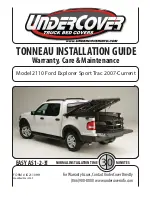
PRACTICAL INFORMATION
107
Tire terminology
The following is a glossary of tire-related terms.
The tire suppliers may have additional markings,
notes or warnings such as standard load, radial
tubeless, etc.
•
Tire information placard
: A placard show-
ing the OE (Original Equipment) tire sizes,
recommended inflation pressure, and the
maximum weight the vehicle can carry.
•
Tire Identification Number (TIN)
: A number
on the sidewall of each tire providing infor-
mation about the tire brand and manufactur-
ing plant, tire size and date of manufacturer.
•
Inflation pressure
: A measure of the
amount of air in a tire.
•
Standard load
: A class of P-metric or Metric
tires designed to carry a maximum load at
35 psi [37 psi (2.5 bar) for Metric tires].
Increasing the inflation pressure beyond this
pressure will not increase the tires load car-
rying capability.
•
Extra load
: A class of P-metric or Metric
tires designed to carry a heavier maximum
load at 41 psi [43 psi (2.9 bar) for Metric
tires]. Increasing the inflation pressure
beyond this pressure will not increase the
tire's load carrying capability.
•
kPa
: Kilopascal, a metric unit of air pressure.
•
PSI
: Pounds per square inch, a standard unit
of air pressure.
•
B-pillar
: The structural member at the side
of the vehicle behind the front door.
•
Bead area of the tire
: Area of the tire next
to the rim.
•
Sidewall of the tire
: Area between the bead
area and the tread.
•
Tread area of the tire
: Area of the perime-
ter of the tire that contacts the road when
mounted on the vehicle.
•
Rim
: The metal support (wheel) for a tire or a
tire and tube assembly upon which the tire
beads are seated.
•
Maximum load rating
: A figure indicating
the maximum load in pounds and kilograms
that can be carried by the tire. This rating is
established by the tire manufacturer.
•
Maximum permissible inflation pressure
:
The greatest amount of air pressure that
should ever be put in the tire. This limit is set
by the tire manufacturer.
•
Recommended tire inflation pressure
:
Inflation pressure, established by Volvo,
which is based on the type of tires that are
mounted on a vehicle at the factory. This
information can be found on the tire inflation
placard(s) located on the driver's side B-pillar
and in the tire inflation table in this chapter.
•
Cold tires
: The tires are considered to be
cold when they have the same temperature
as the surrounding (ambient) air. This tem-
perature is normally reached after the vehicle
has been parked for at least 3 hours.
Содержание V90 2017
Страница 1: ...OWNER S MANUAL SUPPLEMENT ...
Страница 2: ......
Страница 7: ...5 INDEX Index 177 ...
Страница 8: ......
Страница 9: ...INTRODUCTION ...
Страница 50: ......
Страница 51: ...IMPORTANT INFORMATION ...
Страница 88: ......
Страница 89: ...PRACTICAL INFORMATION ...
Страница 149: ...FUSES ...
Страница 156: ... FUSES 154 ...
Страница 162: ......
Страница 163: ...SPECIFICATIONS ...
Страница 165: ...SPECIFICATIONS 163 Location of labels Generic illustration details may vary slightly depending on model market ...
Страница 167: ...SPECIFICATIONS 165 Dimensions The following table lists your vehicle s most important dimensions ...
Страница 174: ... SPECIFICATIONS 172 Related information Engine oil specifications and volume p 173 Coolant specifications p 170 ...
Страница 178: ......
Страница 183: ......
Страница 184: ...TP 23658 English USA Canada AT 1717 MY18 Copyright 2000 2017 Volvo Car Corporation ...
















































